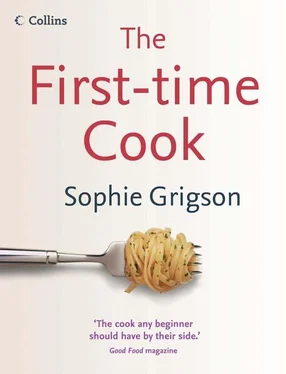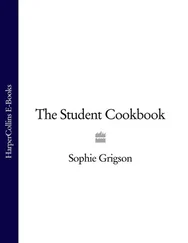At its most elemental, bruschetta (pronounced ‘broos-ket-ah’) is no more than a slice of griddled or char-grilled bread, rubbed with garlic and drizzled with olive oil. This most straightforward form of bruschetta is an ideal accompaniment to antipasti (see above). For a stand-alone bruschetta that is interesting enough to make a first course in its own right, the basic bruschetta is surmounted with any one of hundreds of toppings. A serving of three pieces of bruschetta, each with its own individual character, makes a substantial starter, although you should remember when planning the meal that the bruschette (that’s the proper Italian plural) will need to be made no earlier than half an hour before guests arrive. Even better, they should be griddled and made up at the very last minute so that the bread is still warm, but that may prove just too tricky in terms of timing.
The key to success with bruschette is to source good-quality sturdy bread; if in doubt buy a loaf of pain de campagne or a sourdough loaf. Slice thickly and cut huge slices in half, or even into thirds. Then toast under the grill, or better still griddle to achieve the all-important slightly smoky flavour with a hint of charring (but no more than a hint, please!). It could also be done on the barbecue, but it seems a little excessive to get it going just for a few slices of bread! The toaster is completely out of bounds.
To griddle the bread, you will need to have a ridged griddle pan. Place over a high heat and leave to get really, really hot – allow some 5 minutes for this. Cram as many slices of bread on to it as possible, and turn once the underneath is striped with dark brown. Griddle the other side in the same way.
While the bread is toasting cut a couple of cloves of garlic in half. Rub the garlic lightly over one side of each piece of grilled bread, then drizzle a scant 1/ 2teaspoon of extra virgin olive oil over each piece.
With the toppings, you can really let your imagination go, but to kick-start you, here are three straightforward ideas.
1Halve several well-flavoured tomatoes (you can use cherry tomatoes if necessary), and rub them over the bread, pressing down firmly so that the juices and some of the flesh are smeared over the surface. Top with slices of jamón serrano, or Parma or San Daniele ham.
2Instead of drizzling with olive oil, spread each slice with pesto, then top with sliced buffalo mozzarella, a piece of sun-dried tomato and a sprig of basil.
3Top with rocket, drizzle with a little balsamic vinegar, and finish with shavings of Parmesan. To shave Parmesan, take a vegetable peeler and pull it across the surface of the block of Parmesan to create thin shavings of cheese (see left).
Melon or Figs with Parma Ham
This is one of summer and autumn’s most perfect combinations. The key is learning to choose ripe fragrant fruit. In midsummer it is the melon you should go for, whilst in the autumn the fig reigns supreme. Although you may occasionally find a magnificent melon in midwinter, it is rare, so ignore temptation in the colder months.
For this you are looking for an orange-fleshed melon, in other words a cantaloupe or charentais melon. The paler, white/green-fleshed varieties have a duller taste – not to be sneezed at, but less of a success with salty Parma ham. Use your nose. A ripe melon will smell fragrant and sweet. Press the stalk end gently: if it gives slightly then you are probably on to a winner, but double-check that there are no soft squidgy patches indicating over-ripeness or a mouldy taint. One large melon will be enough for four people.
Ripe figs are tender and fairly soft. Pick them out carefully, avoiding any that are showing patches of brown. Handle them reverently, and place them side by side in a paper bag, settling the bag on top of the rest of your purchases as ripe figs are easily squashed. One or two figs per person is fine.
To serve the melon, cut into eight wedges. Scrape out the seeds and discard. Arrange the slices on individual plates and drape two or three thin slices of Parma ham (or jamón serrano) over each serving.
With the figs, nip the hard stalk tip off each one, then quarter, cutting down towards the base, but stopping just short of it, so that the quarters stay together. Splay them out slightly like the petals of a flower. Place on individual plates, and arrange two or three thin slices of Parma ham (or jamón serrano) alongside them on each plate.
Grilled Goat’s Cheese Salad
Now something of a bistro classic, this is still a great way to start a meal, but does require a brief spell of last-minute work in the kitchen. Keep this to a minimum by preparing everything in advance, so that it’s all ready to go. Choose small drum-shaped goat’s cheeses for this – the sort with a soft, white rind.
For each person you will need a handful of mixed salad leaves (I favour a mix of rocket and spinach, but the choice is entirely yours), about 1/ 2tablespoon of a good vinaigrette (see page 189), a 1/ 2goat’s cheese, a small sprig of rosemary or parsley, a trace of oil (olive or sunflower) and some good (walnut) bread.
Preheat the grill thoroughly and line the grill rack with foil. Arrange the 1/ 2cheese cut-side up on the foil. Brush the cut side with a little oil, then slide under the grill until browned. Meanwhile, toss the salad with the vinaigrette and divide between plates. Top each salad with a sizzling, browned 1/ 2goat’s cheese and finish with a sprig of herb. Serve immediately with toast.
Quick and easy to prepare, guacamole makes a brilliant starter served with warmed pitta bread or tortilla crisps. Alternatively, use it as a sort of relish to serve with grilled fish or meat, or roll up with chicken and peppers in a ‘fajita’ (see page 108).
If you use the smaller Hass avocados you will need three, but with larger avocados two will suffice. The avocados must be ripe and buttery for guacamole.
Serves 4 as a starter
2 tomatoes
1–2 fresh red chillies
a handful of coriander leaves
2–3 ripe avocados
1/2 red onion, peeled and finely diced
juice of 1 lime
salt and pepper
1Deseed and finely dice the tomatoes. Deseed (depending on strength) and finely chop the chillies. Chop the coriander. Skin the avocados, and remove the stones.
2Working quickly, roughly mash the avocado flesh with a fork in a bowl, then mix in all the remaining ingredients. Taste and adjust flavouring, adding more lime if needed. Cover the surface with clingfilm to exclude as much air as possible, thus diminishing the inevitable browning of the avocado. Chill.
3Bring back to room temperature before serving, then stir and scoop into a clean serving bowl.
A decent meal is never far away if you have a stash of eggs in your kitchen. And if you think egg dishes are boring, you’d better revise your thinking right now. An omelette, for example, is an extraordinary vehicle for any number of other ingredients from the minimalism of a grating of Cheddar to the Mediterranean delights of a frittata. The humble fried egg is given a new lease of life with a spot of chilli and garlic, while scrambled eggs take to the fresh zing of citrus juice with consummate ease. One of the best of all egg and cheese combinations, needing just a little butter and flour for substance, is the wicked French gougère, a gorgeously indulgent, gooey cheese pastry that I often knock up for supper or a light lunch. The great thing about all of these simple dishes is that you can tailor them to your own requirements – once you get the basic principles sorted, the imagination can take over (even if it is only to the extent of using up the odds and ends left in the back of the fridge).
Читать дальше












